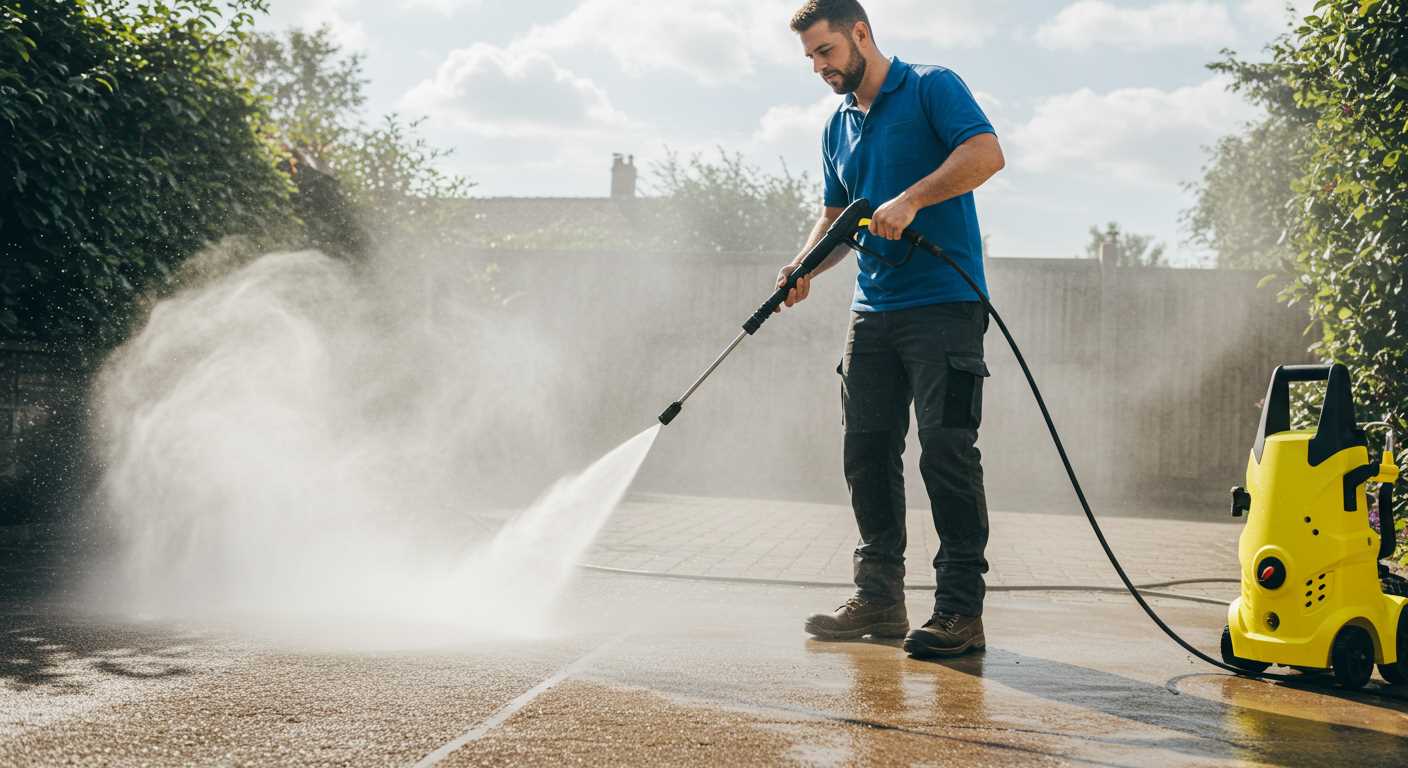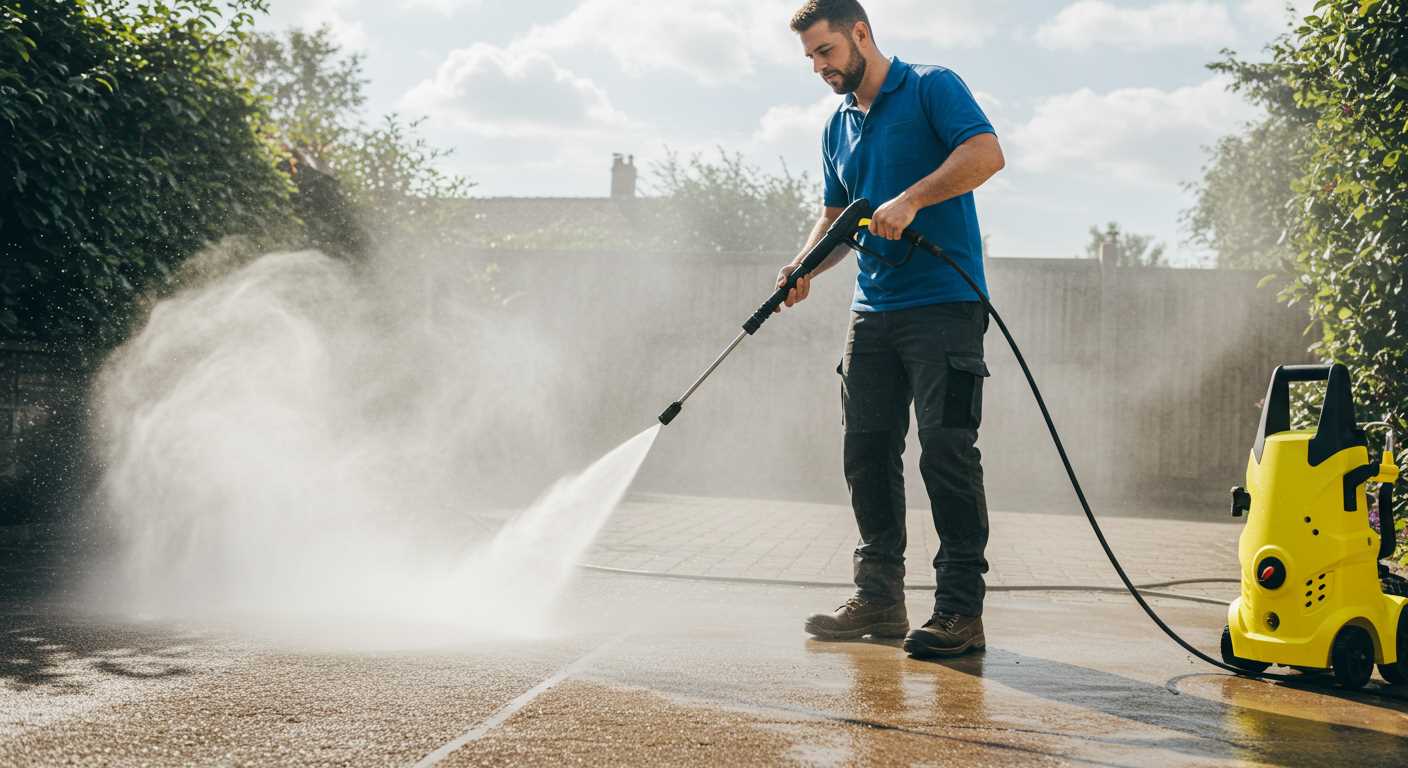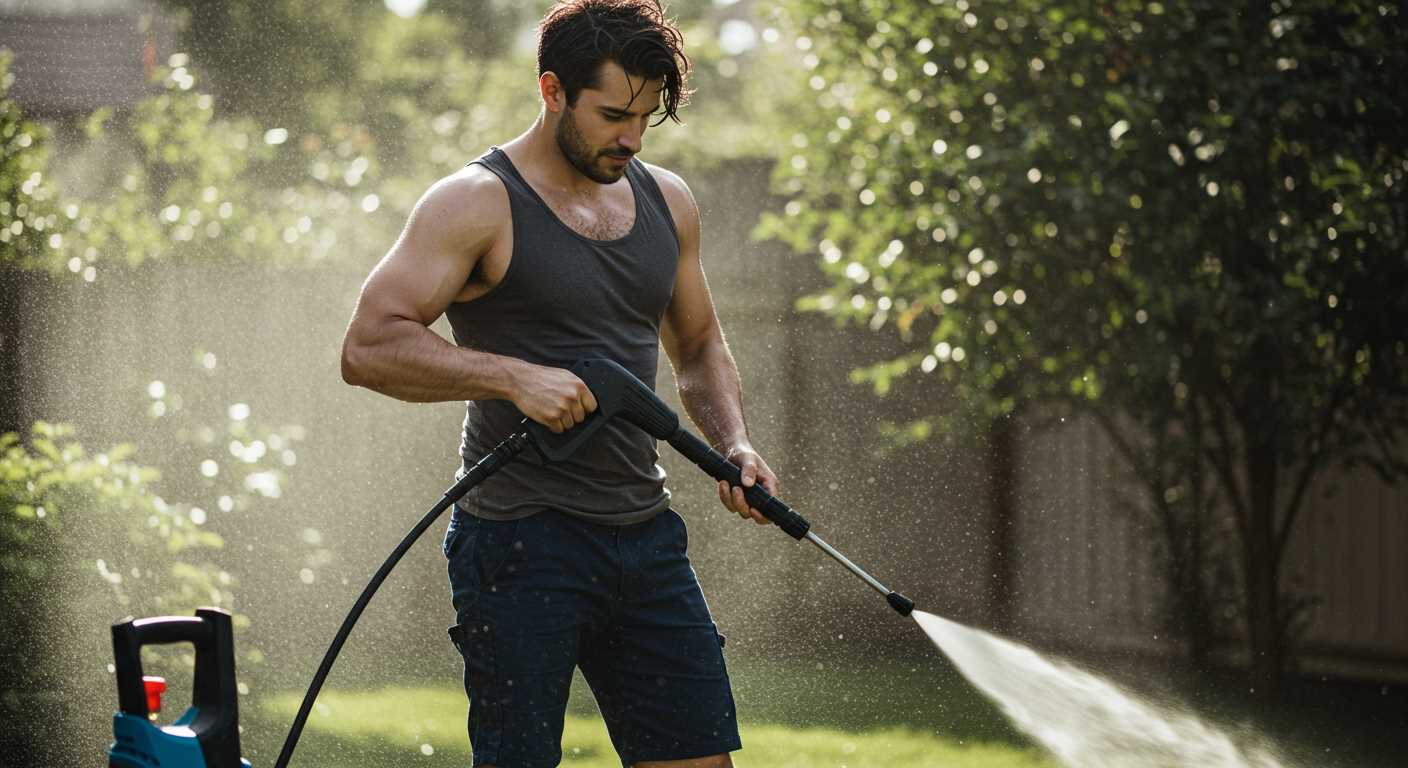




Begin by checking the fuel system. A common issue with these cleaning machines arises from stale fuel. If the engine struggles to start or runs unevenly, drain the old fuel and replace it with fresh gasoline. Make sure to add a fuel stabiliser to prevent future problems.
Next, inspect the spark plug. A worn or dirty spark plug can lead to ignition issues. Remove it using a spark plug wrench, and clean or replace it as needed. I remember one instance when a simple spark plug change saved a customer’s entire day of work.
Don’t overlook the water intake. If the unit is not drawing water efficiently, check the hose and connections for leaks or blockages. I once encountered a unit that seemed broken, but a quick inspection revealed a kinked hose that was the real culprit. Always ensure the water source is adequate and the hose is free of obstructions.
Finally, examine the nozzle and spray gun. Clogged nozzles can significantly reduce performance. Use a small wire or needle to clear any debris, and if the nozzle is damaged, replacing it will restore optimal function. In my experience, a clean nozzle often makes all the difference in achieving that powerful spray.
Repair Recommendations for Your Honda Cleaning Equipment
Begin with checking the fuel system. Ensure you’re using fresh gasoline, as old fuel can cause starting issues. If the fuel looks cloudy or smells off, it’s best to drain the tank and refill it with new petrol. Add a fuel stabiliser if you frequently store your unit for longer periods.
Inspecting the Spark Plug
A faulty spark plug is a common culprit behind starting problems. Here’s how to check it:
- Remove the spark plug using a socket wrench.
- Examine the electrode for wear or carbon build-up. If it appears damaged or excessively dirty, replace it.
- Ensure the gap is set to the manufacturer’s specification using a feeler gauge.
- Reinstall the spark plug, ensuring it’s snug but not overtightened.
Addressing Water Flow Issues
If you notice low water pressure, consider these steps:
- Check the water inlet filter for debris. Clean or replace if necessary.
- Inspect the hoses for kinks or blockages. Straighten them out or replace if damaged.
- Look for leaks around the connections. Tighten them to prevent any loss of pressure.
- Examine the nozzle. A clogged or damaged nozzle can drastically reduce performance. Clean or replace it as needed.
After performing these checks, run the unit to see if the issues are resolved. Regular maintenance can prevent many problems and extend the life of your equipment.
Identifying Common Pressure Cleaner Issues
When a high-pressure cleaner fails to perform, pinpointing the issue can save time and frustration. Start by checking for leaks, as even a small drip can affect pressure. Inspect hoses, connections, and seals for wear or damage. A tight connection is key to maintaining optimal performance.
Symptoms and Solutions
Another frequent problem is inconsistent pressure. This can often be traced back to a clogged nozzle or filter. Regular cleaning of these components ensures a steady flow. Additionally, consider the hose length for pressure washer when evaluating performance; too long can lead to pressure drop.
Checking the Power Source
For electric models, ensure the power supply is stable. A faulty extension cable or loose plug can disrupt functionality. Gas-powered units require regular maintenance of the engine and fuel system. Old fuel or a dirty air filter can hinder performance significantly.
| Issue | Possible Cause | Action |
|---|---|---|
| Leaks | Worn hoses or connections | Inspect and replace damaged parts |
| Inconsistent pressure | Clogged nozzle or filter | Clean or replace as needed |
| Engine won’t start | Fuel issues or spark plug failure | Check fuel quality and replace spark plug |
| Excessive vibration | Imbalanced pump or loose components | Tighten connections and balance the pump |
Checking the Oil Level and Quality
Regular monitoring of the oil level and its condition is key to maintaining optimal performance in your machine. Neglecting this aspect can lead to serious engine issues, so it’s best to stay vigilant.
- Ensure the unit is on a flat surface. This guarantees an accurate reading.
- Remove the dipstick; wipe it clean with a lint-free cloth. This step prevents old oil from contaminating your fresh reading.
- Reinsert the dipstick fully, then remove it again to check the oil level. It should be between the two markings–if it’s low, top it up with the recommended oil type.
Pay attention to the oil’s colour and consistency. Fresh oil is typically amber, while dark or gritty oil indicates it needs a change. If you notice a milky appearance, this could signal coolant contamination, necessitating immediate attention.
- Check for any metallic particles in the oil. This could indicate wear and requires further inspection.
- If you’re unsure about the oil quality, consider changing it. Regular oil changes can significantly extend the life of your engine.
In my experience, I once overlooked an oil quality issue during a busy season. The machine started showing performance drops mid-job, leading to delays. After a quick oil change, it was like night and day. Lesson learned: don’t skip on the basics!
After topping up or changing the oil, ensure to secure the dipstick properly. It’s a small step, but an important one that can prevent leaks and keep everything running smoothly.
Inspecting the Spark Plug for Damage
Remove the spark plug using a socket wrench. Examine it closely for any signs of wear or damage. A healthy plug should be clean with a light brown or grey colour. Look for cracks in the porcelain insulator or heavy carbon build-up, which can indicate issues with combustion.
If the electrode appears worn down or eroded, it’s time for a replacement. A damaged plug can lead to misfiring, reduced power, and hard starting. Make sure to check the gap between the electrodes with a feeler gauge; it should match the specifications outlined in the manual.
After inspecting, ensure the plug is properly tightened but not over-tightened. Reinstall it and secure the lead wire, making sure it’s snug. If you notice repeated damage, consider investigating the fuel quality or air filter condition, as these factors can affect spark plug performance.
Cleaning or Replacing the Water Filter
The water filter is crucial for maintaining optimal performance. If you notice a drop in pressure or irregular flow, the filter could be clogged. Start by turning off the unit and disconnecting the water supply. Locate the filter, which is typically situated at the inlet where the hose connects. Remove it carefully; you might need a screwdriver or pliers, depending on the model.
To clean, rinse it under running water, using a soft brush to dislodge any debris. Avoid using harsh chemicals that could damage the filter material. If cleaning doesn’t restore function, replacing the filter is necessary. You can find compatible filters at hardware stores or online. Ensure you choose the right size to fit your equipment.
When installing a new filter, ensure a snug fit to prevent leaks. Reconnect the water supply and test the equipment. A clean or new filter can often restore lost pressure and improve overall efficiency. Regular maintenance of this component can save you time and money in the long run.
Examining the High-Pressure Hose for Leaks
Start by visually inspecting the entire length of the hose for any signs of wear, such as cracks or frayed areas. A simple visual check can often reveal serious issues. If you notice any damage, it’s best to replace the hose entirely rather than risk further complications during use.
Next, conduct a pressure test to identify hidden leaks. Connect the hose to the machine and turn on the water supply without engaging the trigger. Look for any visible sprays or drips along the hose. If you see water escaping, you may need to replace the damaged section or the entire hose, depending on the severity of the leak.
Pay close attention to the connection points where the hose attaches to the machine and wand. Tighten these fittings to ensure a secure seal. Sometimes, leaks can occur simply because the connections have loosened over time. If tightening doesn’t resolve the issue, inspect the rubber washers inside these fittings. If they are worn or missing, replace them to prevent further leaks.
For a more thorough examination, submerge the hose in a basin of water while it’s pressurised. Look for bubbles forming; this can pinpoint the exact location of a leak. Mark the area for replacement or repair. It’s a method I’ve found particularly useful when dealing with stubborn leaks that don’t show up during visual inspections.
Finally, consider the age and condition of your high-pressure hose. If it’s been in use for several years, it might be time for a replacement, regardless of visible damage. Regular maintenance and timely replacements can save you from more significant issues down the line.
Testing the Unloader Valve Functionality
Begin by disconnecting the high-pressure hose from the unit. This step is critical to ensure safety during testing. With the pressure washer off, examine the unloader valve for any visible signs of damage or blockage. If you notice dirt or debris, clean the valve thoroughly with a soft brush or compressed air.
Next, reconnect the water supply and start the system without the high-pressure hose attached. Listen for a consistent sound from the pump; this indicates that water is flowing properly through the unloader. If you hear a hissing sound or any irregular noises, the valve may be faulty.
Now, reattach the high-pressure hose. With the system running, engage the trigger on the gun and observe the pressure gauge. The reading should spike and then drop back to zero once the trigger is released. If the pressure does not drop, the unloader valve is likely stuck in the closed position, indicating a need for replacement.
Another effective method is to check for leaks around the unloader valve. Use a cloth to wipe the area and look for any traces of water during operation. A leak suggests that the valve is not sealing correctly, which can impact performance.
If everything appears normal but the system still doesn’t operate as expected, consider replacing the unloader valve entirely. It’s a straightforward task that can restore functionality without extensive repairs. Ensure that you have the correct replacement part compatible with your model.
Adjusting the Pressure Settings Correctly
Begin by locating the pressure adjustment knob or dial on your machine, typically situated near the trigger gun or on the unit itself. Set the pressure to a low setting before making any adjustments. This prevents any sudden surges that could cause damage or injury.
As you begin adjusting, gradually increase the pressure while testing the output. I recall a time when I was working on a particularly stubborn stain on a driveway. Initially, I set the pressure too high, which led to chipping the surface. Learning from that experience, I now recommend starting low and testing each increment before committing to a higher setting.
When determining the optimal pressure, consider the surface materials you are cleaning. Delicate surfaces like wood or painted areas require lower settings, while concrete and metal can handle much higher pressure. Here’s a quick reference table to help you choose the right pressure:
| Surface Type | Recommended Pressure (PSI) |
|---|---|
| Wood | 1200 – 1500 |
| Painted Surfaces | 1500 – 2000 |
| Concrete | 2500 – 3000 |
| Metal | 2000 – 2500 |
Always keep an eye on the pressure gauge while working. If you notice a drop in pressure, it could indicate an issue with the water supply or a blockage in the nozzle. Additionally, be mindful of how the adjustment affects the cleaning performance; if you’re not seeing results, it might be time to revisit your settings.
Lastly, for those looking to enhance their cleaning experience, consider pairing your equipment with the best air compressor for cnc machines for added efficiency. Having the right tools can significantly improve the outcome of your cleaning tasks.
Cleaning the Nozzle and Spray Gun
Begin with removing the nozzle from the spray gun. This allows for a thorough cleaning process, ensuring optimal performance. A clogged or dirty nozzle can drastically reduce water flow and pressure.
- Soak the nozzle in a mixture of warm water and vinegar for about 30 minutes. This helps dissolve any mineral deposits or debris.
- Use a soft brush, like an old toothbrush, to gently scrub the nozzle opening. Be careful not to damage the orifice.
- Rinse the nozzle under warm running water to remove any remaining residue.
- Inspect the nozzle for any cracks or damage. If damaged, replacement is necessary for proper function.
Next, address the spray gun. It’s crucial to keep this component clean as it affects the overall operation.
- Detach the spray gun from the high-pressure hose.
- Check the trigger mechanism to ensure it’s not stuck. A stuck trigger can hinder water flow.
- Wipe down the exterior of the spray gun with a damp cloth, focusing on any crevices where dirt may accumulate.
- Examine the O-rings and seals for wear. Replace any that appear cracked or worn, as these can lead to leaks.
After cleaning, reassemble the nozzle and spray gun, ensuring all components fit securely. Run a test to confirm that the water flows smoothly and the spray pattern is even. Keeping these parts clean not only prolongs their lifespan but also enhances the efficiency of the entire cleaning system.
Winterising Your Equipment
To prevent damage during the cold months, ensure to drain all remaining water from the system. Start by disconnecting the water supply and running the machine until no more water flows from the nozzle. This step eliminates the risk of freezing and cracking internal components.
After draining, add a stabiliser to the fuel tank. This keeps the fuel fresh and prevents gumming in the carburettor. I often use a fuel stabiliser specifically designed for small engines, as it works wonders over the long winter.
Next, remove and clean the spark plug. A clean plug is crucial for easy starting come spring. If you notice any wear or damage, replace it to avoid issues later on. I remember one winter, I neglected this step and ended up with a stubborn unit that just wouldn’t start.
For those with detachable nozzles, take a moment to clean them thoroughly. Any debris left can lead to clogs and reduced performance. I usually soak mine in warm soapy water and use a soft brush to ensure they’re in perfect condition.
Lastly, store the unit in a dry, sheltered location. If possible, keep it indoors to protect it from extreme conditions. I’ve learned from past experiences that even a small amount of moisture can wreak havoc on internal parts if left outside. A little preparation now saves a lot of hassle later.



.jpg)

.jpg)


